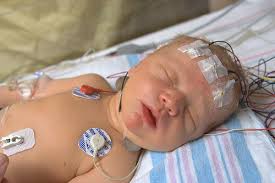 The temporal evolution of electrographic seizure burden in neonatal hypoxic ischemic encephalopathy
The temporal evolution of electrographic seizure burden in neonatal hypoxic ischemic encephalopathy
Epilepsia. 2012 Feb 6. doi: 10.1111/j.1528-1167.2011.03401.x. [Epub ahead of print]
Source
Department of Paediatrics and Child Health, University College Cork, Cork, Ireland Neonatal Brain Research Group, University College Cork, Cork, Ireland Elizabeth Garrett Anderson Institute for Women's Health, University College London Hospitals, London, United Kingdom.
Abstract
Purpose: Hypoxic ischemic encephalopathy (HIE) accounts for 60% of all neonatal seizures. There is emerging evidence that seizures cause additional injury to the developing brain that has sustained hypoxic ischemic injury. Temporal evolution of clinical seizure burden in HIE has been characterized, with maximum clinical seizure burden (the period of maximum seizure activity) being observed between 12 and 24 h of age. The purpose of our study was to investigate the distribution of electrographic seizure burden (the accumulated duration of seizures over a defined time period), following the initial hypoxic ischemic insult.
Methods: Fifteen full-term newborns with HIE and seizures, and a minimum of 48 h of continuous video-electroencephalography (EEG), were included in this retrospective study. Medical records of the infants were reviewed and details of clinical seizures and antiepileptic drugs were recorded. The time of maximum seizure burden was defined as the midpoint of an hour-long window, shifted in time by 1 s across the full EEG recording, which contained the maximum duration of seizures. The degree of temporal evolution of seizure burden within this period was tested. Temporal evolution was further analyzed by segmenting the time series into two periods; the time between the first recorded seizure and the maximum seizure burden (T(1) ), and the time between the maximum seizure burden and the last recorded seizure (T(2) ). Seizure burden, duration, and number of seizures per hour were analyzed within each time period.
Key Findings: EEG was commenced at a median of 14 h of age. Maximum electrographic seizure burden was reached at a median age of 22.7 h. Time from first recorded seizure to maximum seizure burden (T(1) ) was significantly shorter than time from maximum seizure burden to last recorded seizure (T(2) ) (p-value = 0.01). Median seizure burden during T(1) was significantly higher than during T(2) (p-value = 0.007). There is temporal evolution of electrographic seizure burden in full-term newborns with HIE. There is a short period of high seizure burden (T(1) ) followed by a longer period of lower seizure burden (T(2) ).
Significance: Understanding the temporal evolution of seizure burden in HIE contributes further to our understanding of neonatal seizures, helps identify an optimal therapeutic window for seizure treatment, and provides a benchmark against which to measure the efficacy of new and innovative forms of neuroprotection and antiepileptic medication.
Editors note: Seizures are common in the NICU in babies with hypoxia. A common question for the neurologist in the NICU is "When are we out of the wood with seizures?"
Significance: Understanding the temporal evolution of seizure burden in HIE contributes further to our understanding of neonatal seizures, helps identify an optimal therapeutic window for seizure treatment, and provides a benchmark against which to measure the efficacy of new and innovative forms of neuroprotection and antiepileptic medication.
Editors note: Seizures are common in the NICU in babies with hypoxia. A common question for the neurologist in the NICU is "When are we out of the wood with seizures?"
No comments:
Post a Comment